
PUMPA - SMART LEARNING
எங்கள் ஆசிரியர்களுடன் 1-ஆன்-1 ஆலோசனை நேரத்தைப் பெறுங்கள். டாப்பர் ஆவதற்கு நாங்கள் பயிற்சி அளிப்போம்
Book Free DemoThe lesson "Glimpses of the Past" is written by S.D.Sawant. The first scene depicts a function that was held in Delhi. In the function, Lata Mangeshkar was singing a Hindi song, "Ae mere watan ke logon". The central theme of the song speaks about the life of martyrs who sacrificed their lives for the welfare of the nation. Martyrs are people who face challenges and undergo great sufferings in order to save the lives of others or the country from evil forces. Lata Mangeshkar sang the song in remembrance of people who lost their lives in the First War of Indian Independence. The famous personalities sitting by her side were Pandit Jawaharlal Nehru, Lal Bahadur Shastri, and Indira Gandhi.
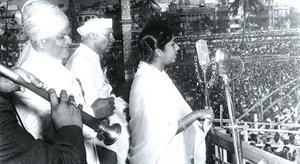
Lata Mangeshkar can be seen singing a song. Beside her Jawaharlal Nehru and Lal Bahadur Shastri can be seen
While listening to the heart-melting song, Nehru's eyes filled with tears. Likewise, the audience was listening to her song with tears in their eyes. Some of the great leaders who gave their lives for our nation were Bhagat Singh, Mahatma Gandhi, Subash Chandra Bose, and Jhansi Rani Lakshmi Bai. The freedom fighters are the reason we are living in an independent India. Their blood and sacrifices saved our country from the crooked Britishers. From her song, it was clear how many struggles our martyrs faced in bringing up our India as an independent one.
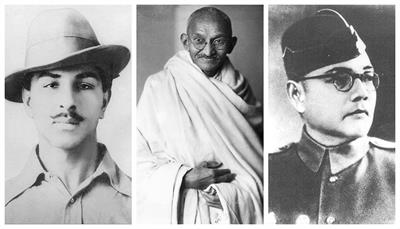
Indian martyrs: Bhagat Singh, Mahatma Gandhi and Subash Chandra Bose (Left to Right)
The year\(1757\) was marked as an important year in Indian History because it was the entry of the East India Company in India. The East India Company is also known as the British East India Company. The East India Company was a private company owned by stockholders and reporting to the administration in London. Later on, the East Indian Company came to India and set up a few factories in different places.
Slowly and gradually, the East India company began expanding and extending their power in India. One of the primary reasons the Britishers were able to survive in India was that they possessed superior weapons.
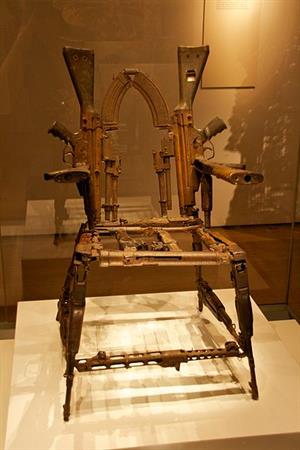
Secondly, they took advantage of the weakness of Indian princes. The Britishers however, considered Indian princes as “short-sighted”, because of the inability to see the long term plans of the Britishers. The Indian princes themselves felt that they were not strong enough to fight with Raja Bah. Moreover, the people had no peace due to such constant fights. So, they took help from the Britishers and thought that the Britishers would help them defeat their enemies. Later on, the Britishers started to take all the powers and controls from the Indian rulers. The Britishers considered Indians as weak ones.

The Britishers considered Indian princes as “short-sighted”
Compared to the other Indian princes, one ruler of Mysore called Tipu Sultan understood the British policy and fought against them until his last breath. Unfortunately, due to his fate, Tipu Sultan got defeated and died on the battlefield. Among all the Indian princes, Tipu Sultan was a brave man who fought for the goodness of the people, and he thought to save the country from British rule.
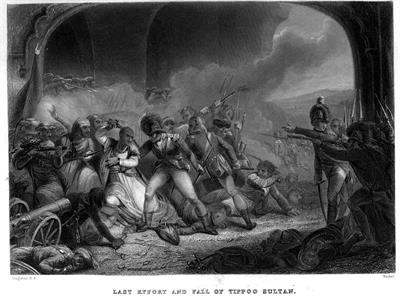
During\(1765\) , Indian territories were ruled by the Indian princes, and only a few regions were under British control. But after the entry of the Britishers and their powerful weapons, everything started to change.
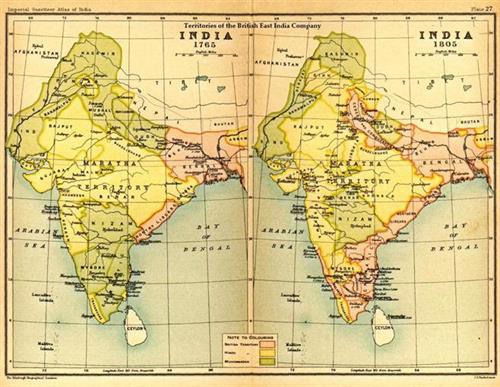
After the conquest or British rule in Indian territories, a few people were satisfied with their rule, and a few were against their conquest. The Indians had varied opinions and reactions about the British rule. The royal people brought the Britishers inside India so they were pleased with the Britishers and were also grateful because they thought that due to the arrival of Britishers they put an end to the enemies. The royal men felt the British rule put an end to the constant wars and struggles with their enemies. The royal people believed that God had sent them in the form of saviours, and their fate was connected with them.
On the other hand, the common people noticed the dishonest behaviour of the Britishers. They thought that the English man had arrived here for killing the kings or taking away the throne from them. The Indians knew that even if some of the princes were unfit, they belonged to their country. They thought that the decision of the Indian princes turned them into slaves of the Britishers.
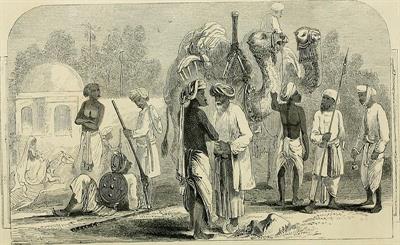
The common people were dissatisfied with the rule of Britishers
The years from \(1765\) to \(1836\), led to the wide spread of superstitious beliefs like untouchability, child marriage, and the inferiority of women. The religious leaders taught the people about the idea of untouchability. Untouchability refers to rejecting a group of people from important places in the name of custom, caste and religion. They were not allowed to come near those who considered themselves superior (higher castes), not allowed in temples and functions. The religious leaders even preached that people who "cross the seas" will no longer belong to their religion. Women were considered the major cause for all the problems like poverty and other miseries. This is the reason why young girls were forced to marry, thereby leading to Child Marriage. These practices were not only being done but were also being promoted by the superior people.
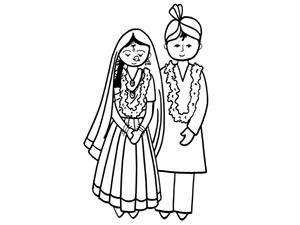
Child marriage
The Britishers started looking down upon Indians and initiated brainwashing the rulers against them. It was the primary strategy of the Britishers to bring the Indians under their control. They believed that Indians were not worthy of trust and "incapable of honesty". This was a way of making the Indian people as their slaves and they took power over them.
Every day the Britishers introduced new rules and regulations to torture the Indians. The Britishers needed quick profits in their business. They increased heavy taxes on the poor farmers. As a result, the farmers had to give up their lands. When the poor farmers tried to raise question against the Britishers, they would threaten the farmers. The Britishers said they would put the poor farmers in jail if they did not pay their arrears.
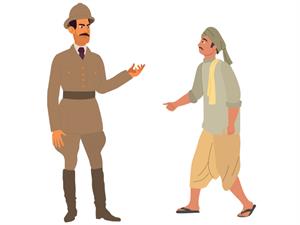
The Britisher threatening the farmer when he was raising question
The Britishers continuously found many ways to exploit the people and to earn profits. For instance, the goods manufactured in England were being imported to India, and they won't be charged for importing. The England products were sold at high prices in India, whereas the products made in India were taken away at lower prices by the Britishers. As a result, there was an increase in poverty, and one could see the farmers' struggle. Not only this, such policies of the British East India Company destroyed the Indian industries too. The rule of the Britishers destroyed small businesses and individual artisans. Artisans lost their job because of the arrival of British East India Company.
Finally, the rule of the Britishers resulted in an extreme shortage of food and death. Between 1822 and 1836, fifteen lakhs of Indians died because of the scarcity of food.
Finally, the rule of the Britishers resulted in an extreme shortage of food and death. Between 1822 and 1836, fifteen lakhs of Indians died because of the scarcity of food.
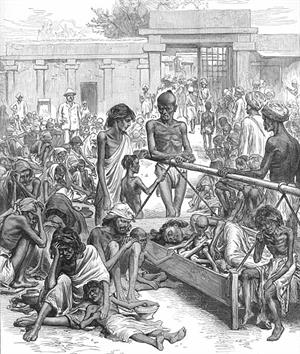
Famine in India during British rule
Raja Ram Mohan Roy was a well-known educated man and a great social reformer. He came from Bengal. Roy understood there was something wrong with the country, and it was due to the arrival of the Britishers. Raja Ram Mohan Roy informed to fellow member that they must not consider themselves inferior or look down upon themselves. He believed that the ancient culture of Indians was great and the people were capable of more remarkable achievements. Raja Ram Mohan Roy thought that the first step was to change the society by destroying the false belief that the Britishers came to India to save them. It was the leading cause of all the problems.
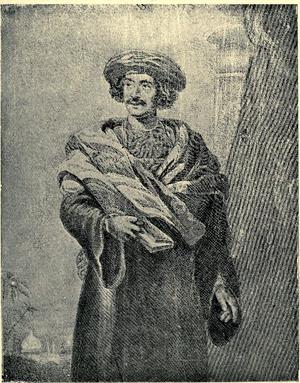
Raja Ram Mohan Roy, a learned man from Bengal
One day, while Raja Ram Mohan Roy was having a conversation with his wife Uma, he told her that, "Cows are of different colours, but the colour of their milk is the same. So likewise, different teachers might have different opinions, but the essence of each religion remains the same." From these two statements, Raja Ram Mohan Roy conveyed that even though peoples are of different colours, their blood remains the same. The religions are compared to teachers here because both believes in imparting wisdom and knowledge. Though there are several gods and religions around us, Raja Ram Mohan Roy believed that the essence remained the same in all of them.
Later on, Raja Ram Mohan Roy took a great interest in learning science and modern technology. According to him, learning should be practical and scientific. So Raja Ram Mohan Roy started to publish newspapers in India. Roy's newspapers were considered an important tool to criticize the anti-Indian and anti-people policies of the East India Company government. He also raised various demands to the government through his newspapers. However, the suspicious Britishers came to know about Roy's newspaper, and so they put an end to the newspaper in 1823.
Raja Ram Mohan Roy was very interested in knowing what made the Britishers more powerful, so he travelled across the seas and visited England. There, he met the Britishers and said that the Indians had accepted the Britishers as their rulers, and so they must accept the Indians as their subjects (followers or citizens). He added the point that the Britishers could not forget their responsibility and duty towards their country people. And also, Roy stated that the Britishers should know their subjects' goodness rather than destroying them.
Raja Ram Mohan Roy is mainly known for his efforts to abolish the practice of child marriage and Sati. Sati or suttee was a historical Hindu practice in which a widow sacrifices herself by sitting at the top of her husband's funeral pyre.
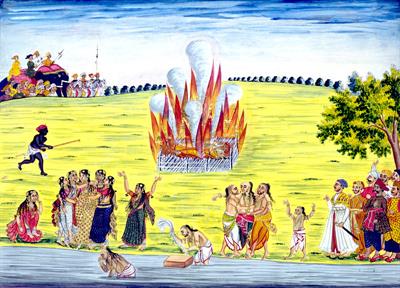
Sati system
The Britishers continued to trouble Indians in different ways by putting them in jail. They gave sufferings and struggles for Indians by passing a new law called Regulation III. The Regulation III act was passed in the year 1818. The main motive of implementing this law was to put the Indians in jail without producing them in front of the court. The Regulation act was taken place illegally to torture the Indians. The Britishers knew that if the Indians were brought before the court, they would escape in the form of justice. So the Britishers cunningly passed the Regulation III act.
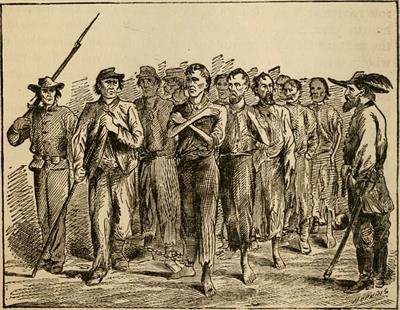
The Britishers treated Indians as slave and put them in bars
As they continued to suppress Indians, they created all sorts of favourable things to improvise their officers and belongings. As a result, the British officers drew enormous salaries from their bank, and they invested money in new business. Later on, they had found good profits in their new business too.

The Britishers earned enormous money in their new business
The Britishers were exporting goods in huge quantities from Britain. By 1829, they were importing goods worth seven crore rupees to India. As a result, the Britishers grew richer and more prosperous, leaving the Indian industries poor. In the end, the Indian industries collapsed entirely and started to fall.
Later on, governor-general Bentinck stated to Britain that "The bones of cotton weavers are bleaching the plains of India". This means that the cotton weavers were forced to starve because of the Britishers' cotton mills. They produced much cheaper cloth with the help of machines that led the traditional Indian handicrafts to extinction. This was the reason behind the traditional workers losing their weaving jobs.
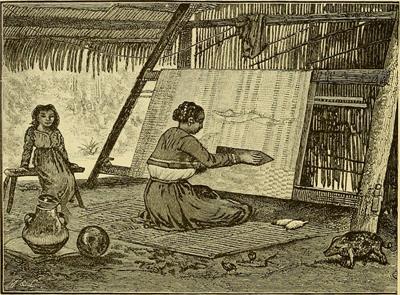
Indian weavers lost their jobs due to the Britishers' cotton mills
Earlier all the teachings of Indians were in the form of Persian and Sanskrit language. Later on, a British officer named Macaulay suggested to Bentinck that the Indians must follow only the English language and so all other Persian and Sanskrit languages to be translated into English. So that the education is thoroughly delivered in their language. The fellow member agreed with the idea of Macaulay.
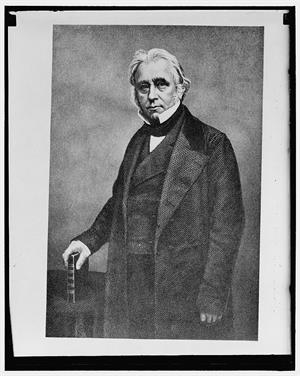
Thomas Babington Macaulay
The British people taught English to the Indian people who did clerical tasks and administrative duties like answering the phone and typing the documents. By introducing the English language, the Britishers produced a whole new generation of masterminds. A few of the Indians were on the side of Britishers desired that they wanted to improve their peoples' lifestyle by educating them. They tried to strengthen their financial prospects that could lead to a promising future. But they needed to convey this to the British Parliament. Britishers, on the other hand, never cared about the needs of the Indian people.
Later on, the Indians had become more worried about their kings. Several people were sitting under the tree and discussing how to drive the Britishers out. Their Kings were being treated like puppets. They were unable to raise their power against the Britishers.
Later on, the Indians had become more worried about their kings. Several people were sitting under the tree and discussing how to drive the Britishers out. Their Kings were being treated like puppets. They were unable to raise their power against the Britishers.
The ever-increasing taxes started to destroy the peasants. The increased tax continued to pressure the people and worsen their financial situation. The Santhals in Bengal became worried and hopeless after losing their land to the Britishers under the new land laws. The Santhals are the member of a large indigenous group living mainly in Eastern India. Due to anger, the Santhals protested through a terrific war against the Europeans in 1855. They killed the Europeans and those who supported the Europeans.
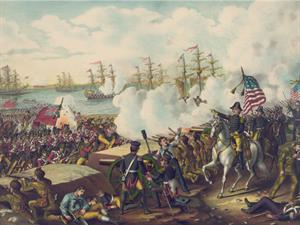
A terrific war
The soldiers working under the Britishers were highly dissatisfied because of the Britishers. The reason for hating Britishers was they gave good pay for the Englishmen, big houses to stay, and other help. But for Indians, they offered only less money and slow promotions. The Indian soldiers cannot afford running their family with that income. So they hated the Britishers for showing partiality among people.
The Indian soldier's felt terrible because the people of England urged them to move out from their land to cross the sea and work for them. Crossing the sea was considered to be against their religion and as per their religious leaders. So the Indian soldiers were angry with the English leaders. The Indian soldiers argued that who had given them the rights to speak about their old customs and traditions.
The Indian soldier's felt terrible because the people of England urged them to move out from their land to cross the sea and work for them. Crossing the sea was considered to be against their religion and as per their religious leaders. So the Indian soldiers were angry with the English leaders. The Indian soldiers argued that who had given them the rights to speak about their old customs and traditions.
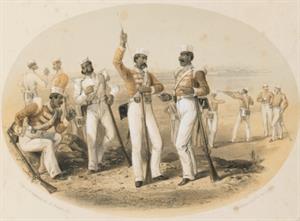
Indian soldiers can be seen having a conversation with each other about the partiality of the Britishers
After hearing that, an Indian soldier serving under British or European orders named Sepoy Mangal Pande thought to himself that he must drive the Britishers out from India. Later on, Mangal Pande attacked the British military forces, and so he was executed (killed). After that, thousands of other sepoys like Mangal Pande took violent action against the Britishers, but the Britishers took away their weapons and uniforms, and they put the sepoys in jail. The reason behind putting the sepoys behind bars was they were fighting against the English men.
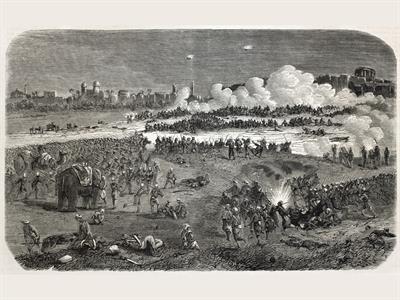
Thousands of sepoy were fighting with the Britishers
The Englishmen were least bothered about the thoughts, beliefs and traditions of Indians. An Indian man told a Brahmin soldier that the bullets they were supposed to bite were made from the fats of cows and pigs. The Brahmin soldiers should open the cartridges containing gun powders and they need to fill them in the guns. After hearing that the grease on the bullet was made of the fat of pigs and cows, the Brahmins felt very angry. Because Brahmins are supposed to worship cows. Finally they came to a thought that the English men had betrayed them.
Later on, the Indians planned to defeat the Britishers. So chapaties were being sent to each home in every village, conveying that their services could be required to fight against the Englishmen. The chapati movement involved the unusual distribution of thousands of chapaties across several Indian villages during 1857. It is probably believed that the chapaties were distributed to convey a message of the native emperor seeking help from the nearby region. The ultimate origin of the movement is unknown, though the Britishers believed that the chapaties might contain secret notes or messages to trap them. People agreed that they would support their emperors. Lotus flowers were circulated among the Indian soldiers because it was the national flower of India. The nation stood against the Britishers, and the Indian people gave shelter and adequate help for the patriots. Patriots are the persons who vigorously support their country and prepares to fight against their enemies.
Later on, the Indians planned to defeat the Britishers. So chapaties were being sent to each home in every village, conveying that their services could be required to fight against the Englishmen. The chapati movement involved the unusual distribution of thousands of chapaties across several Indian villages during 1857. It is probably believed that the chapaties were distributed to convey a message of the native emperor seeking help from the nearby region. The ultimate origin of the movement is unknown, though the Britishers believed that the chapaties might contain secret notes or messages to trap them. People agreed that they would support their emperors. Lotus flowers were circulated among the Indian soldiers because it was the national flower of India. The nation stood against the Britishers, and the Indian people gave shelter and adequate help for the patriots. Patriots are the persons who vigorously support their country and prepares to fight against their enemies.
The revolt of \(1857\) is otherwise known as India’s First War of Independence and Sepoy Mutiny. The revolt started on May 10, 1857, at Meerut. Sepoys initiated the revolt in the Bengal Presidency against the British officers. The leading cause for the first war of Indian independence was that the Britishers made the Brahmin soldiers to bite the cartridge before loading it into the gun. Indian sepoys believed that the cartridge was greased with either pig fat or made from cow fat. This was against their sentiments. This was believed to be the primary factor for the revolt of 1857.
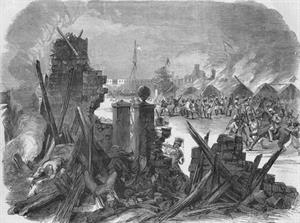
Violent revolt at Meerut
The urge to free the nation from the Britishers continued to grow among the Indian soldiers. The city of Meerut also experienced the violent attack of the Britishers. The sepoys marched towards Delhi to see Emperor Bahadur Shah.
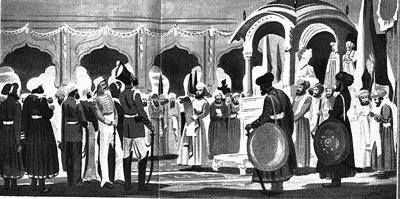
Sepoys marched to Delhi to meet Emperor Bahadur Shah
Many former rulers like Begum Hazrat Mahal of Lucknow was very angry with the Britishers because the Englishmen had taken control over her kingdom. Leaders like Maulvi Ahmedulla of Faridabad called out his people and said, "Rise, brothers, rise! The Angrez is ruining our land!" He motivated his country people that they are going to free the country from the hands of the Englishmen. To save the country, they need the support of the Indian soldiers. After hearing that, the people of Bareilly, Kanpur and Allahabad came forward in the protest against Britishers.
Entire North India came together in large numbers to fight against the Britishers. At that time, Azimulla Khan expressed his thoughts to Tatya Tope that they should have Peshwa Nana Saheb as their leader in this war of Indian Independence. Later on, the patriots fought against the Britishers and the war spread all over North India.
Entire North India came together in large numbers to fight against the Britishers. At that time, Azimulla Khan expressed his thoughts to Tatya Tope that they should have Peshwa Nana Saheb as their leader in this war of Indian Independence. Later on, the patriots fought against the Britishers and the war spread all over North India.
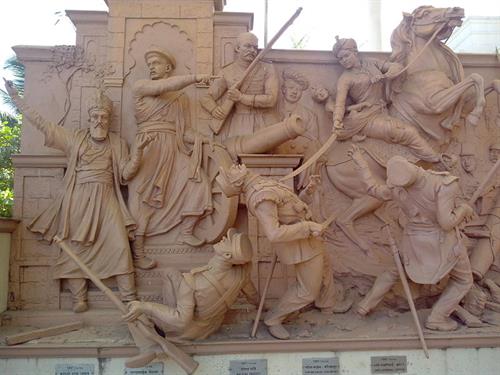
War of Indian Independence (only for reference)
In this revolt, an eighty-year-old warrior named Kunwar Singh of Bihar was attacked by the enemies. Kunwar Singh got hit by a bullet on his wrist during the fight. So he cut of his hand in order to avoid more damage to his health and dedicated it to Mother Ganga (river) as an offering.
In this revolt, an eighty-year-old warrior named Kunwar Singh of Bihar was attacked by the enemies. Kunwar Singh got hit by a bullet on his wrist during the fight. So he cut of his hand in order to avoid more damage to his health and dedicated it to Mother Ganga (river) as an offering.
Reference: